Best Classical
Guitar String
-
Overall: 9/10
-
Best Feature: Ball end design for easy installation
-
TedScore™: 9/10
Best Acoustic
Guitar String
-
Overall: 9/10
-
Best Feature: High-quality coating for enhanced durability and longevity
-
TedScore™: 9/10
Best Electric
Guitar String
-
Overall: 9/10
-
Best Feature: Balanced tension for comfortable playing and easy bending
-
TedScore™: 9/10
While you’re busy strumming and feeling the rhythm, you may wonder “how often should you change guitar strings”?
Well, here’s the deal: similar to how a fresh cup of coffee or a new pair of socks can add energy to your day, regularly changing your guitar strings can bring a similar liveliness to your playing.
It will maintain a sparkling and vibrant sound and give your guitar a rejuvenating experience – ensuring it stays in tune, improving its tone, and preventing any unexpected breakage during a jam session.
So, let’s get started on how to show your guitar some love by changing strings!
Importance of Changing Guitar Strings Regularly
Regularly changing guitar strings is important for maintaining optimal sound quality and playability.
As guitar strings age and accumulate dirt, sweat, and oils from your fingers, they can produce a dull and muted sound. By changing your strings regularly, you can ensure a bright and vibrant tone.
Also, worn-out or dirty strings can be harder to fret and bend, which can affect your ability to play smoothly.
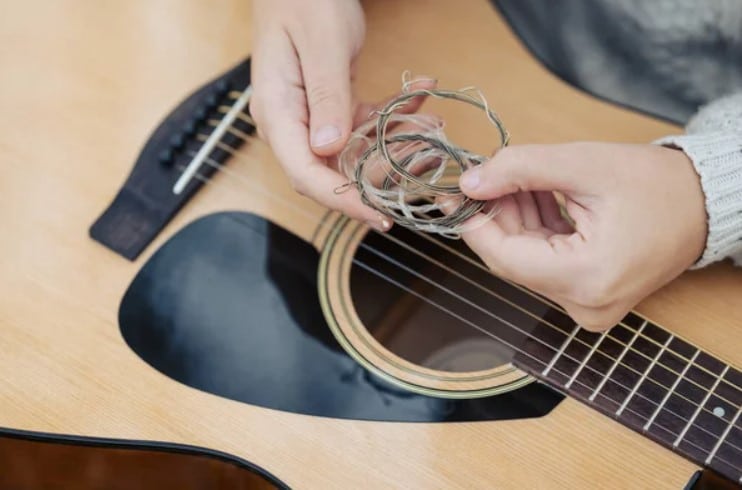
Fresh strings provide better intonation and responsiveness, enhancing your overall playing experience.
Signs That It's Time to Change Guitar Strings
Whether you’re a beginner or an experienced guitarist, knowing when to change your guitar strings is essential for maintaining optimal sound quality and playability.
Over time, old guitar strings can wear out and lose their ability to produce the desired tone. Here are some signs that indicate it’s time to change your guitar strings:
Changes in tone and sound quality
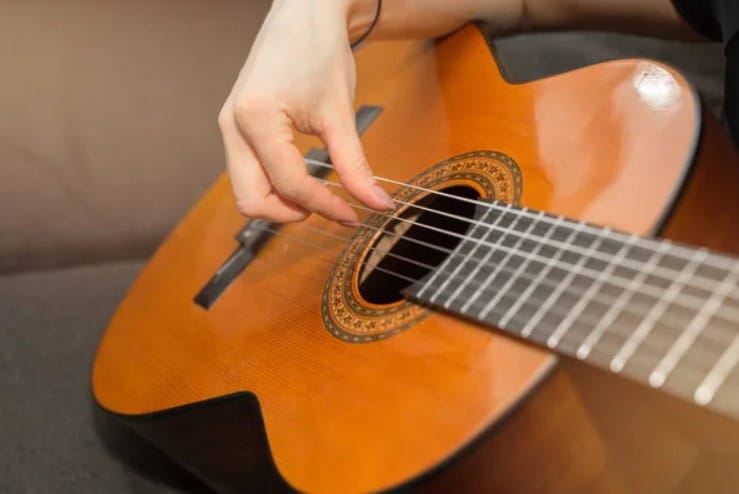
Visible signs of wear and tear
Inspect your strings regularly for visible signs of wear and tear.
Look for rust, discoloration, fraying, or flat spots on the strings.
These signs indicate that the strings have reached the end of their lifespan and should be replaced.
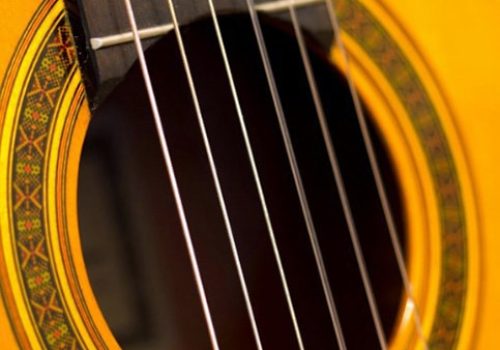
Difficulty in tuning and intonation
If you find it increasingly challenging to tune your guitar accurately or experience intonation issues where certain fretted notes sound out of tune,
It may be due to worn-out strings.
Fresh strings will improve tuning stability and intonation.

Frequency of String Changes for Different Types of Players
Beginners and Casual Players
If you’re a beginner guitarist or a casual player who practices a few times a week,
You can typically get away with changing your guitar strings every 3 to 6 months.
Since you’re not putting as much wear and tear on the strings, they will last longer before they lose their tone and playability.

Regular Gigging Musicians
For musicians who perform regularly at gigs or play in a band,
Changing your guitar strings every 1 to 2 months is recommended.
The constant playing, sweating, and bending of the strings
During live performances can cause them to deteriorate faster.

Changing them more frequently with new set of strings will ensure you always have fresh-sounding strings for your performances.
Recording and Professional Guitarists
Recording and professional guitarists often require the highest tone and playability from their strings.
They should change their guitar strings every 1 to 2 weeks or even more frequently if they’re recording extensively or performing at high-profile events.
Fresh strings will provide the best sound quality and responsiveness for professional recordings and performances.

Remember, these are general guidelines, and the frequency of string changes may vary depending on personal preference, playing style, and the type of strings used.
It’s always a good idea to regularly inspect your strings for signs of wear and change them as needed to maintain optimal sound quality
Different Types of Guitar Strings and Their Lifespan
Nylon Strings
If you play classical or flamenco guitar, you probably use nylon strings. These strings sound clear and are known for their warm and mellow tone.
Nylon strings tend to last longer than other guitar strings, with an average lifespan of 2 to 3 months.
However, this can vary depending on how often you play and your style.
It’s essential to regularly check for signs of wear and tear, such as fraying or discoloration, and replace them when necessary.
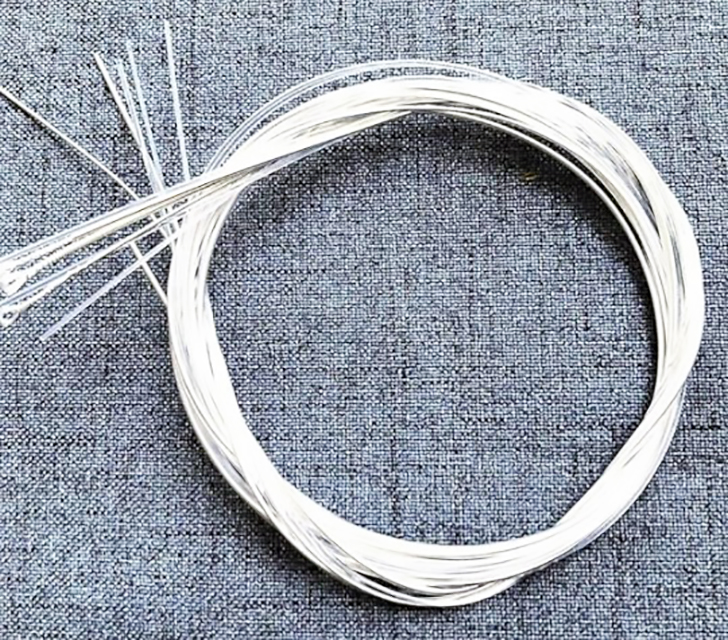
Steel Strings (Acoustic and Electric)
Steel strings are commonly used on acoustic and electric guitars. They produce a bright and vibrant tone.
Steel strings generally have a shorter lifespan than nylon strings, lasting around 1 to 2 months. Humidity, temperature, and playing style can affect the strings and their longevity.

Coated Strings
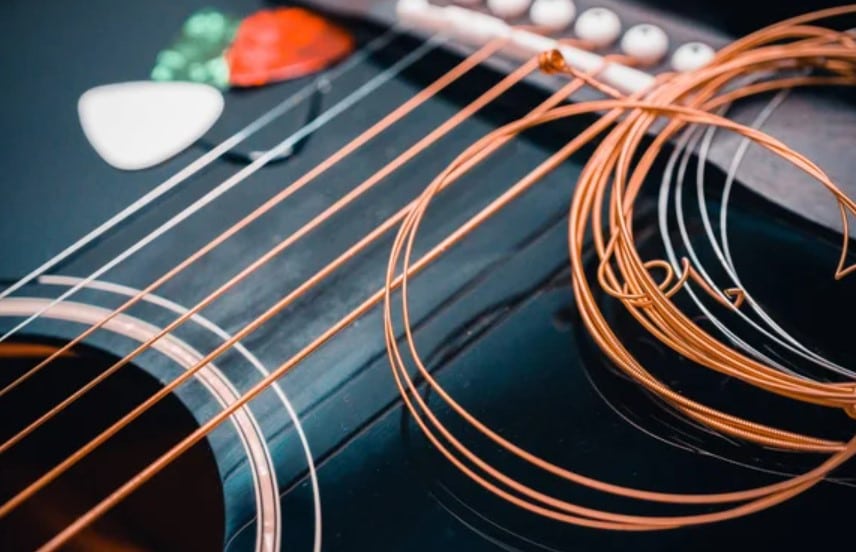
Our Best Recommended Guitar Strings
D'Addario EJ32C Folk Nylon Classical Guitar Strings with Ball End

FEATURES: -High-quality nylon construction
-Ball end design for easy installation
-Suitable for both classical and folk music styles
- Exceptional tonal quality and projection
- Durable and long-lasting, minimizing the need for frequent string changes
- Versatile, suitable for a wide range of playing techniques and musical styles
- May require some time to break in and stabilize their tuning
When you click ‘Check Price’, you’ll see there are loads of great places to buy this item. Our personal favorite is Sweetwater for the US, and Thomann and Gear4Music for the UK & Europe.
They are the largest music retailers, with excellent customer service, competitive prices, really fast shipping, and the longest guarantees.
The professional musician who wrote this article combined many things,
from the product build, manufacturer’s reputation through to feedback
from other users, to create our famous TedScore™.
Fender Dura-Tone Coated Acoustic Strings

FEATURES: High-quality coating for enhanced durability and longevity
-Corrosion-resistant properties to prevent rust and maintain clarity of tone
-Balanced and warm sound suitable for various musical genres
- Increased lifespan compared to traditional acoustic strings
- Consistent and reliable performance even in harsh playing conditions
- Versatile tone that suits different playing styles and musical genres
- Coated strings may feel slightly different compared to uncoated strings initially
When you click ‘Check Price’, you’ll see there are loads of great places to buy this item. Our personal favorite is Sweetwater for the US, and Thomann and Gear4Music for the UK & Europe.
They are the largest music retailers, with excellent customer service, competitive prices, really fast shipping, and the longest guarantees.
The professional musician who wrote this article combined many things,
from the product build, manufacturer’s reputation through to feedback
from other users, to create our famous TedScore™.
Ernie Ball Regular Slinky 2221 Nickel Electric Guitar Strings

FEATURES:-High-quality nickel-plated steel construction for enhanced durability and tone
-Balanced tension for comfortable
playing and easy bending
-Bright and expressive sound output for a wide
range of musical styles
- Excellent tone and sustain
- Smooth and reliable tuning stability
- Long-lasting and resistant to breakage
- May require frequent restringing for heavy players
- Can be slightly expensive compared to other
When you click ‘Check Price’, you’ll see there are loads of great places to buy this item. Our personal favorite is Sweetwater for the US, and Thomann and Gear4Music for the UK & Europe.
They are the largest music retailers, with excellent customer service, competitive prices, really fast shipping, and the longest guarantees.
The professional musician who wrote this article combined many things,
from the product build, manufacturer’s reputation through to feedback
from other users, to create our famous TedScore™.
Elixir Optiweb Coated Electric Guitar Strings

FEATURES:-Optiweb coating for long-lasting
performance and tone
-Nickel-plated steel <br<construction for enhanced durability
-Bright and expressive sound output for a wide
range of musical styles
- Excellent tone and clarity due to the Optiweb coating
- Increased string life and durability; they last longer than traditional uncoated strings
- Comfortable to play with a smooth feel, reducing finger noise and string squeak
- Pricier than some string brands
When you click ‘Check Price’, you’ll see there are loads of great places to buy this item. Our personal favorite is Sweetwater for the US, and Thomann and Gear4Music for the UK & Europe.
They are the largest music retailers, with excellent customer service, competitive prices, really fast shipping, and the longest guarantees.
The professional musician who wrote this article combined many things,
from the product build, manufacturer’s reputation through to feedback
from other users, to create our famous TedScore™.
D’Addario NYXL Bass Guitar Strings

FEATURES:-High carbon steel core for increased strength and improved string life.
-Enhanced mid-range frequency
response for a bold and powerful tone.
-NY Steel wrap wire for better magnetic properties
and increased sustain.
- Excellent tuning stability even during aggressive playing or heavy bending.
- Longer string life compared to traditional bass strings.
- Enhanced tonal consistency across different playing styles and musical genres.
- Slightly higher price compared to regular bass strings.
- May require some adjustments to your bass setup due to the increased tension.
When you click ‘Check Price’, you’ll see there are loads of great places to buy this item. Our personal favorite is Sweetwater for the US, and Thomann and Gear4Music for the UK & Europe.
They are the largest music retailers, with excellent customer service, competitive prices, really fast shipping, and the longest guarantees.
The professional musician who wrote this article combined many things,
from the product build, manufacturer’s reputation through to feedback
from other users, to create our famous TedScore™.
Tips for Prolonging the Lifespan of Guitar Strings
Proper cleaning and maintenance
To keep your guitar strings in optimal condition and extend their lifespan, cleaning and maintaining them regularly is important. Here are a few tips to help you with this:
Wipe down your strings after each use: In order to prevent the accumulation of dirt, sweat, or oils on your guitar strings, it’s advised to utilize a clean cloth or specialized string cleaner to wipe them down after each use.
Use a string cleaner: Invest in a good quality string cleaner and use it to remove any stubborn grime or residue from your strings.
Avoid excessive bending: Excessive strings bending can cause them to wear out faster. Be mindful of how much you bend the strings while playing.
Correct storage practices
Proper storage of your guitar when not in use can also help prolong the lifespan of your strings. Here are some storage tips:
Use a guitar case or gig bag: Keeping your guitar in a case or gig bag when not in use protects it from dust, humidity, and temperature changes that can affect the strings.
Avoid extreme temperatures: Extreme heat or cold can cause the strings to expand or contract, leading to potential damage. Store your guitar in a temperature-controlled environment.
Loosen the strings: If you won’t be playing your guitar for an extended period, consider loosening the strings slightly to relieve tension and reduce stress on them.
Step-by-Step Guide to String Replacement
Guide to String Replacement
Loosen the old strings: Start by loosening the tension on each string using the tuning pegs. This will make it easier to remove them.
Remove the old strings: Carefully unwind each string from the tuning pegs and remove them from the bridge.
Clean the guitar: Take this opportunity to clean your guitar, especially the fretboard and bridge area.
Install new strings: Starting with the thickest string (low E), thread it through the bridge and up to the corresponding tuning peg. Repeat this process for each string, ensuring they are properly seated in their respective slots.
Tune and stretch the strings: Once all the new strings are installed, tune them to the desired pitch. Then, gently stretch each string by pulling it away from the fretboard to help them settle in.

Tools and Techniques for Efficient String Changes
Tools and Techniques
String winder: A string winder can speed up removing and installing strings by quickly winding or unwinding them on the tuning pegs.
String cutter: After installation, use a string or wire cutter to trim excess string length.
Proper winding technique: When winding the new strings onto the tuning pegs, wrap neatly and evenly to prevent slipping or tuning stability issues.

How Often Should You Change Guitar Strings
Key Takeaways
As a guitar player, you may wonder how often you should change your guitar strings to maintain optimal playability and sound quality.
The general rule of thumb is to change your strings every 1-3 months, depending on your guitar playing, frequency, and style.
Remember that these are general guidelines, and the frequency of string changes may vary depending on factors such as humidity, climate, and personal preference.
Listening to your guitar and gauging when the strings lose their brilliance and playability is essential.
Regularly changing your guitar strings ensures that your instrument stays in top shape, providing you with the best playing experience and sound quality possible.
So remember to give your guitar some love by changing to fresh strings regularly!
Before you go…
Experience unparalleled sound quality and durability with our 20 Best Guitar Strings.
Whether you’re a professional musician, intermediate guitarist or a beginner, these strings will make your guitar sing with smoothness, richness, and precision, elevating your playing to new heights!
FAQ's
You can tell when your guitar strings need changing by looking for signs of wear and tear, such as discolouration, rust, or visible fraying.
You may notice a very dull sound or muted sound, difficulty tuning or staying in tune.
On average, guitar strings can last between one to three months, depending on how frequently you play guitar, the type of strings you use, and the conditions in which you play.
Professional guitarists often change their strings before every performance or recording session to ensure optimal sound quality and playability when playing guitar.
However, the frequency of string changes may vary depending on the individual’s playing style and preferences.
Yes, it’s generally okay to do string change on all guitar strings at once. Many guitarists prefer to do so to ensure consistent sound quality and playability with same strings across all strings.
However, some guitarists may choose to only change strings only one or a few strings at a time to avoid sudden tone or tension changes.











Regarding your section on nylon strings, I found it particularly enlightening. One often overlooks their resilience and nuanced sound characteristics in favor of more modern steel or coated variants. However, it’s essential to note that the tonal qualities of nylon strings can significantly augment the expressiveness of classical and flamenco pieces. Additionally, your emphasis on proper maintenance and regular replacement schedules reinforces the importance of discipline in string instrument upkeep, a principle many beginners unfortunately neglect.
man i never knew there was such a big deal about guitar strings i just play till they break guess thats why my sound always been a bit off compared to recordings gotta step up my game and maybe look into those coated ones sounds like a game changer lol
Absolutely, coated strings changed my life. Worth every penny.
You’d be surprised how much of a difference new strings make! But don’t wait till they break; it’s all about the sound quality and playability.
Excellent guide, Hugh Richardson! It’s crucial to understand the difference coated strings can make, especially for those of us living in more humid climates. They really do last longer!
hey, got a q. how do u know exactly when it’s time to swap out guitar strings? mine sound a bit off but not sure if it’s just me being picky. cheers.